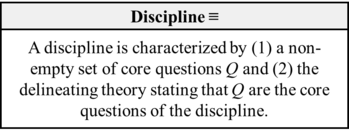Status of Disciplinary Boundaries
How do disciplinary boundaries exist within the scientific mosaic?
A community's mosaic consists of the set of all accepted theories and employed methods by the community at some particular time. How do disciplinary boundaries exist within the mosaic: are they expressible as theories and/or methods?
In the scientonomic context, this term was first used by Hakob Barseghyan in 2016. The term is currently accepted by Scientonomy community.
In Scientonomy, the accepted definition of the term is:
- A discipline is characterized by (1) a non-empty set of core questions Q and (2) the delineating theory stating that Q are the core questions of the discipline.
Contents
Scientonomic History
Acceptance Record
| Community | Accepted From | Acceptance Indicators | Still Accepted | Accepted Until | Rejection Indicators |
|---|---|---|---|---|---|
| Scientonomy | 1 April 2016 | It was acknowledged as an open question by the Scientonomy Seminar 2016. | Yes |
All Theories
| Theory | Formulation | Formulated In |
|---|---|---|
| Discipline (Patton-Al-Zayadi-2021) | A discipline is characterized by (1) a non-empty set of core questions Q and (2) the delineating theory stating that Q are the core questions of the discipline. | 2021 |
If an answer to this question is missing, please click here to add it.
Accepted Theories
| Community | Theory | Accepted From | Accepted Until |
|---|---|---|---|
| Scientonomy | Discipline (Patton-Al-Zayadi-2021) | 21 February 2024 |
Suggested Modifications
| Modification | Community | Date Suggested | Summary | Verdict | Verdict Rationale | Date Assessed |
|---|---|---|---|---|---|---|
| Sciento-2021-0006 | Scientonomy | 1 August 2021 | Accept new definitions of subquestion, core question, core theory, discipline, delineating theory, subdiscipline, and discipline acceptance. | Accepted | Prior to the 2024 workshop, Hakob Barseghyan commented on the encyclopedia indicating his support for accepting this modification and noted its potential to underpin further work on discipline dynamics. In fact, a significant amount of observational scientonomy work has been carried out in the past few years (including the paper on the rejection of alchemy by Friesen and Patton (2023),1 as well as some more recent papers) that presupposes the acceptance of these definitions, despite the fact that the modification containing them formally remains open. There was very little discussion about the modification, beyond raising points for the community to look forward to in the future, like a brief discussion between Jamie Shaw and Paul Patton about the need for more research on the difference between disciplines and disciplinary communities. The modification was accepted unanimously with 18 votes. | 21 February 2024 |
Current View
In Scientonomy, the accepted definition of the term is Discipline (Patton-Al-Zayadi-2021).
Discipline (Patton-Al-Zayadi-2021) states: "A discipline is characterized by (1) a non-empty set of core questions Q and (2) the delineating theory stating that Q are the core questions of the discipline."
A discipline A is characterized by a non-empty set of core questions QCA and a delineating theory stating that QCA are the core questions of the discipline.2
The scientific mosaic consists of theories and questions.3456 As a whole, a discipline A consists of a set of accepted questions QA, and the theories which provide answers to those questions, or which those questions presuppose. 2 Questions form hierarchies, with more specific questions being subquestions of more general questions. Theories find a place in these hierarchies, since each theory is an attempt to answer a certain question, and each question presupposes certain theories. Because of such hierarchical relations, it is possible to characterize a discipline by identifying a set of core questions, QCA. These core questions are judged by some agent to be related to one another, essential to a discipline, and definitive of its boundaries. The other questions of a discipline are subquestions of its core questions.
A set, as such, can't be part of a scientific mosaic consisting of theories and questions. We, therefore, take a discipline to be defined by a delineating theory that identifies the set of core questions QCA characterizing that discipline.
Related Topics
This question is a subquestion of Ontology of Scientific Change.
This topic is also related to the following topic(s):
References
- ^ Friesen, Izzy and Patton, Paul. (2023) Discipline Dynamics of Chymistry and Rejection of Alchemy. Scientonomy 5, 93-110. Retrieved from https://scientojournal.com/index.php/scientonomy/article/view/42268.
- a b Patton, Paul and Al-Zayadi, Cyrus. (2021) Disciplines in the Scientonomic Ontology. Scientonomy 4, 59-85. Retrieved from https://scientojournal.com/index.php/scientonomy/article/view/37123.
- ^ Barseghyan, Hakob. (2015) The Laws of Scientific Change. Springer.
- ^ Barseghyan, Hakob. (2018) Redrafting the Ontology of Scientific Change. Scientonomy 2, 13-38. Retrieved from https://scientojournal.com/index.php/scientonomy/article/view/31032.
- ^ Rawleigh, William. (2018) The Status of Questions in the Ontology of Scientific Change. Scientonomy 2, 1-12. Retrieved from https://scientojournal.com/index.php/scientonomy/article/view/29651.
- ^ Sebastien, Zoe. (2016) The Status of Normative Propositions in the Theory of Scientific Change. Scientonomy 1, 1-9. Retrieved from https://www.scientojournal.com/index.php/scientonomy/article/view/26947.
